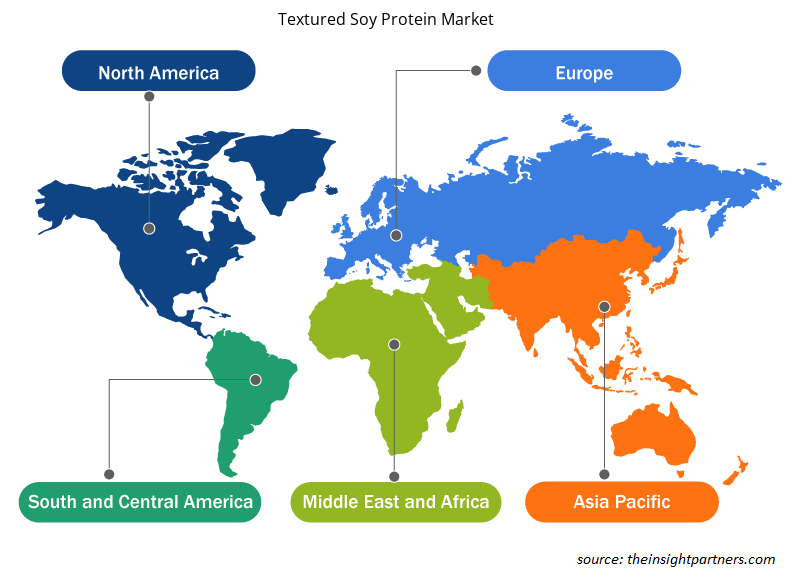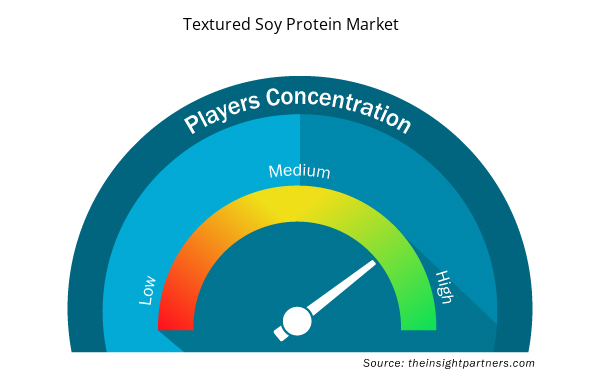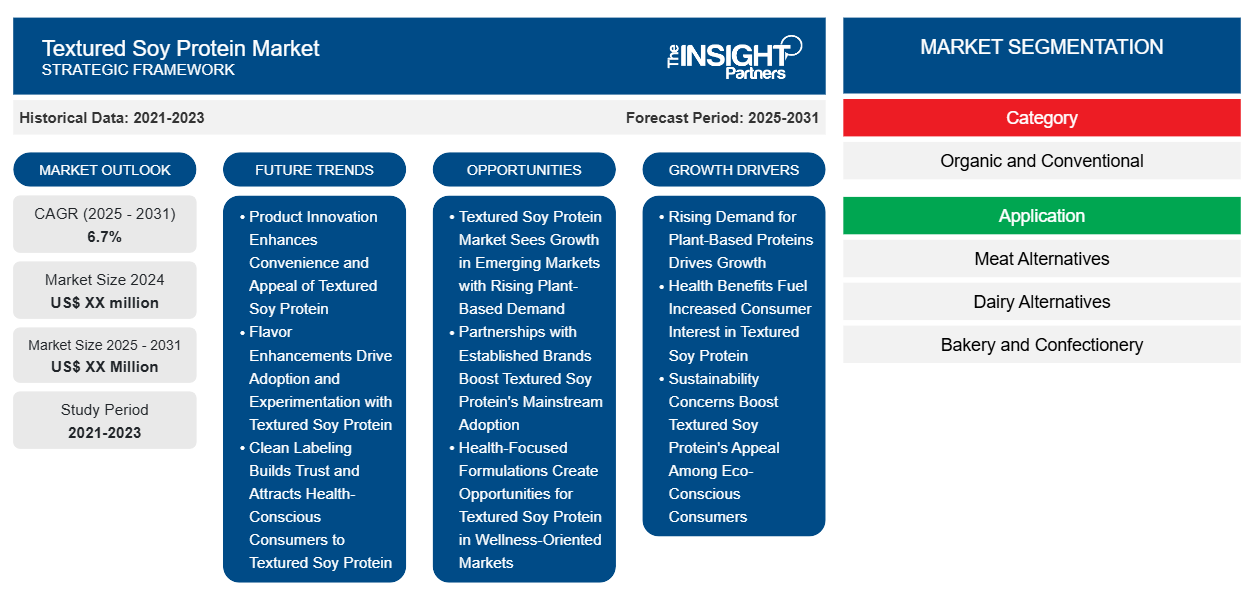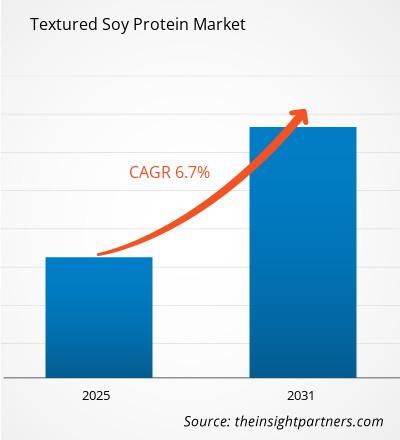Se espera que el mercado de proteína de soja texturizada registre una CAGR del 6,7 % entre 2024 y 2031, con un tamaño de mercado que se expandirá de US$ XX millones en 2024 a US$ XX millones en 2031.
El informe está segmentado por categoría (orgánica y convencional). El informe presenta además un análisis basado en la aplicación (alternativas a la carne, alternativas a los lácteos, panadería y confitería, snacks dulces y salados, nutrición infantil y otros). El alcance del informe cubre cinco regiones: América del Norte, Europa, Asia Pacífico, Medio Oriente y África, y América del Sur y Central y los países clave de cada región. El análisis global se desglosa aún más a nivel regional y por países principales. El informe ofrece el valor en USD para el análisis y los segmentos anteriores.
Propósito del Informe
El informe Textured Soy Protein Market de The Insight Partners tiene como objetivo describir el panorama actual y el crecimiento futuro, los principales factores impulsores, los desafíos y las oportunidades. Esto proporcionará información a diversas partes interesadas del negocio, como:
- Proveedores/fabricantes de tecnología: Para comprender la dinámica cambiante del mercado y conocer las oportunidades potenciales de crecimiento, lo que les permitirá tomar decisiones estratégicas informadas.
- Inversionistas: Realizar un análisis exhaustivo de tendencias sobre la tasa de crecimiento del mercado, las proyecciones financieras del mercado y las oportunidades que existen en toda la cadena de valor.
- Órganos reguladores: Regular las políticas y vigilar las actividades del mercado con el objetivo de minimizar los abusos, preservar la confianza de los inversores y defender la integridad y la estabilidad del mercado.
Segmentación del mercado de proteína de soja texturizada
Categoría
- Orgánico y convencional
Solicitud
- Alternativas a la carne
- Alternativas a los lácteos
- Panadería y Confitería
- Snacks dulces y salados
- Nutrición infantil
- Otros
Personalice este informe según sus necesidades
Obtendrá personalización en cualquier informe, sin cargo, incluidas partes de este informe o análisis a nivel de país, paquete de datos de Excel, así como también grandes ofertas y descuentos para empresas emergentes y universidades.
- Obtenga las principales tendencias clave del mercado de este informe.Esta muestra GRATUITA incluirá análisis de datos, desde tendencias del mercado hasta estimaciones y pronósticos.
Factores impulsores del crecimiento del mercado de proteína de soja texturizada
- La creciente demanda de proteínas de origen vegetal impulsa el crecimiento: el mercado de la proteína de soja texturizada está fuertemente impulsado por la creciente demanda de proteínas de origen vegetal. Los consumidores son cada vez más vegetarianos y veganos y, por lo tanto, necesitan alternativas a la carne enriquecidas con nutrientes. La comodidad con el aspecto y la sensación, como la capacidad de asemejarse a las texturas y el sabor de la carne, es uno de los principales atractivos de la proteína de soja texturizada.
- Los beneficios para la salud impulsan un mayor interés de los consumidores en la proteína de soja texturizada: la proteína de soja texturizada está experimentando un mayor crecimiento en el mercado debido a que los consumidores son más conscientes de su valor nutricional. Rica en proteínas, fibra y aminoácidos esenciales, la proteína de soja texturizada nutre los músculos y el bienestar general. Con un bajo contenido de grasa y nutrientes beneficiosos, los consumidores preocupados por la salud quieren que se añada más proteína de soja texturizada a las comidas y los refrigerios.
- Las preocupaciones por la sostenibilidad aumentan el atractivo de la proteína de soja texturizada entre los consumidores con conciencia ecológica: otra preocupación que impulsa el mercado de la proteína de soja texturizada es la preocupación por la sostenibilidad. La gente está optando por alimentos mucho más ecológicos, y la proteína de soja texturizada tiene una menor huella de carbono y requiere menos recursos en comparación con las proteínas animales. Las preocupaciones por la sostenibilidad a nivel de consumidor no son en vano, ya que el creciente interés de los consumidores en las dietas sostenibles conducirá a una mayor demanda de proteína de soja texturizada a medida que los consumidores con conciencia ecológica la disfruten.
Tendencias futuras del mercado de proteína de soja texturizada
- La innovación de productos mejora la comodidad y el atractivo de la proteína de soja texturizada: las innovaciones en los productos son cambios que se producen en el mercado de la proteína de soja texturizada, y un actor presenta una variedad de ofertas de comidas listas para comer, bocadillos y sustitutos de carne. Estas innovaciones satisfacen diversas preferencias y también se suman a las necesidades dietéticas de los consumidores, mejoran la comodidad y atraen a quienes buscan opciones nutritivas basadas en plantas que se adapten a los estilos de vida modernos.
- Las mejoras de sabor impulsan la adopción y la experimentación con proteína de soja texturizada: la mejora del sabor es una tendencia que está surgiendo rápidamente en la proteína de soja texturizada. En esta categoría, las marcas están experimentando con especias, adobos y condimentos atrevidos para ofrecer los productos más deliciosos y versátiles que existen. El sabor de la proteína de soja texturizada la hace muy atractiva para los consumidores, lo que promueve una mayor adopción y una mayor experimentación en la cocina casera.
- El etiquetado limpio genera confianza y atrae a los consumidores preocupados por la salud hacia la proteína de soja texturizada: el etiquetado limpio está en fuerte auge en el mercado de la proteína de soja texturizada, ya que los consumidores exigen cada vez más ingredientes más transparentes. Los productos deben desarrollarse a partir de ingredientes naturales reconocibles sin compuestos artificiales añadidos. Esto favorece el establecimiento de la confianza de los consumidores en los productos y atrae a los consumidores saludables y sofisticados que buscan opciones de alimentos simples y saludables para sus dietas.
Oportunidades de mercado para la proteína de soja texturizada
- El mercado de proteínas de soja texturizadas crece en los mercados emergentes con una creciente demanda de productos de origen vegetal: la creciente demanda de proteínas de origen vegetal impulsa el mercado de proteínas de soja texturizadas" El mercado de proteínas de soja texturizadas tiene un gran potencial de crecimiento en los mercados emergentes donde las dietas basadas en plantas se están volviendo populares. Los consumidores con un ingreso disponible cada vez mayor buscan opciones de alimentos más saludables. Las marcas podrán dar forma a sus productos de acuerdo con la cultura y las preferencias locales, presentarlos a nuevos segmentos y lograr un crecimiento del volumen de ventas en una región culturalmente diversa.
- Las asociaciones con marcas consolidadas impulsan la adopción generalizada de la proteína de soja texturizada: existen varias oportunidades con las marcas de alimentos consolidadas, pero para los productores de proteína de soja texturizada, trabajar con empresas de alimentos de marca consolidadas sería beneficioso. Las empresas de alimentos de marca consolidadas sin duda podrán añadir proteína de soja texturizada a los productos de aperitivo populares, las comidas preparadas o los productos alternativos a la carne para mejorar su visibilidad y credibilidad. Esto sin duda crearía entusiasmo por las pruebas de los consumidores y convertiría a la proteína de soja texturizada en un ingrediente de uso generalizado en las cuotas de mercado.
- Las fórmulas centradas en la salud crean oportunidades para la proteína de soja texturizada en los mercados orientados al bienestar: las fórmulas que tienen en cuenta la salud son una oportunidad interesante. Los productos podrían formularse para incluir las vitaminas, los minerales o los ingredientes funcionales específicos que los consumidores conscientes de su salud podrían estar buscando. El enfoque en el bienestar puede ser potencialmente un factor diferencial en un mercado competitivo y dar acceso a un grupo de nicho de rápido crecimiento que busca alimentos nutritivos.
Perspectivas regionales del mercado de proteína de soja texturizada
Los analistas de Insight Partners explicaron en detalle las tendencias y los factores regionales que influyen en el mercado de proteína de soja texturizada durante el período de pronóstico. Esta sección también analiza los segmentos y la geografía del mercado de proteína de soja texturizada en América del Norte, Europa, Asia Pacífico, Oriente Medio y África, y América del Sur y Central.

- Obtenga datos regionales específicos para el mercado de proteína de soja texturizada
Alcance del informe de mercado de proteína de soja texturizada
| Atributo del informe | Detalles |
|---|---|
| Tamaño del mercado en 2024 | XX millones de dólares estadounidenses |
| Tamaño del mercado en 2031 | US$ XX millones |
| CAGR global (2024 - 2031) | 6,7% |
| Datos históricos | 2021-2023 |
| Período de pronóstico | 2025-2031 |
| Segmentos cubiertos | Por categoría
|
| Regiones y países cubiertos | América del norte
|
| Líderes del mercado y perfiles de empresas clave |
|
Densidad de actores del mercado de proteína de soja texturizada: comprensión de su impacto en la dinámica empresarial
El mercado de proteína de soja texturizada está creciendo rápidamente, impulsado por la creciente demanda de los usuarios finales debido a factores como la evolución de las preferencias de los consumidores, los avances tecnológicos y una mayor conciencia de los beneficios del producto. A medida que aumenta la demanda, las empresas amplían sus ofertas, innovan para satisfacer las necesidades de los consumidores y aprovechan las tendencias emergentes, lo que impulsa aún más el crecimiento del mercado.
La densidad de actores del mercado se refiere a la distribución de las empresas o firmas que operan dentro de un mercado o industria en particular. Indica cuántos competidores (actores del mercado) están presentes en un espacio de mercado determinado en relación con su tamaño o valor total de mercado.
Las principales empresas que operan en el mercado de proteína de soja texturizada son:
- Compañía Midland de Archer Daniels
- Grupo Bremil
- Cargill, Incorporada.
- Grupo de proteína de soja Crown
- Nutrición y Salud DuPont
Descargo de responsabilidad : Las empresas enumeradas anteriormente no están clasificadas en ningún orden particular.

- Obtenga una descripción general de los principales actores clave del mercado de proteína de soja texturizada
Puntos de venta clave
- Cobertura integral: el informe cubre de manera integral el análisis de productos, servicios, tipos y usuarios finales del mercado de proteína de soja texturizada, proporcionando un panorama holístico.
- Análisis de expertos: el informe se compila sobre la base de un profundo conocimiento de expertos y analistas de la industria.
- Información actualizada: El informe asegura relevancia comercial debido a su cobertura de información reciente y tendencias de datos.
- Opciones de personalización: este informe se puede personalizar para satisfacer los requisitos específicos del cliente y adaptarse adecuadamente a las estrategias comerciales.
Por lo tanto, el informe de investigación sobre el mercado de proteína de soja texturizada puede ayudar a abrir camino para descifrar y comprender el escenario de la industria y las perspectivas de crecimiento. Si bien puede haber algunas preocupaciones válidas, los beneficios generales de este informe tienden a superar las desventajas.
- Análisis histórico (2 años), año base, pronóstico (7 años) con CAGR
- Análisis PEST y FODA
- Tamaño del mercado Valor/volumen: global, regional, nacional
- Industria y panorama competitivo
- Conjunto de datos de Excel


- Pharmacovigilance and Drug Safety Software Market
- HVAC Sensors Market
- Energy Recovery Ventilator Market
- Skin Tightening Market
- Clear Aligners Market
- Hair Extensions Market
- Arterial Blood Gas Kits Market
- Electronic Toll Collection System Market
- Vaginal Specula Market
- Transdermal Drug Delivery System Market

Report Coverage
Revenue forecast, Company Analysis, Industry landscape, Growth factors, and Trends

Segment Covered
This text is related
to segments covered.

Regional Scope
North America, Europe, Asia Pacific, Middle East & Africa, South & Central America

Country Scope
This text is related
to country scope.
Preguntas frecuentes
Demand for transparency prompts brands to adopt clean-label practices in product formulations is expected to be the key market trend
The report can be delivered in PDF/Word format, we can also share excel data sheet based on request.
On the basis of geography, the textured soy protein market is classified into North America, Europe, Asia Pacific, Middle East and Africa, and South and Central America
The major factors driving the textured soy protein market are:
1. Increased interest in plant-based diets boosts demand for textured soy protein.
2. High in protein and essential amino acids, it appeals to health-conscious consumers.
Cargill Inc, DuPont, Sonic Biochem, Bremil Group, Archer-Daniels-Midland Co, CROWN SOYA PROTEIN GROUP, Kansas Protein Foods, Victoria Group, Sun Nutrafoods, Foodchem International Corp, and Merit Functional Foods
The Textured Soy Protein Market is estimated to witness a CAGR of 6.7% from 2023 to 2031
Trends and growth analysis reports related to Food and Beverages : READ MORE..
1. Archer Daniels Midland Company
2. Bremil Group
3. Cargill, Incorporated.
4. Crown Soya Protein Group
5. DuPont Nutrition and Health
6. Dutch Protein and Services B. V.
7. HungYang Foods, Co, Ltd
8. Shandong Yuxin Bio-Tech Co. , ltd.
9. Victoria Group A. D.
10. Wilmar International Ltd
The Insight Partners performs research in 4 major stages: Data Collection & Secondary Research, Primary Research, Data Analysis and Data Triangulation & Final Review.
- Data Collection and Secondary Research:
As a market research and consulting firm operating from a decade, we have published and advised several client across the globe. First step for any study will start with an assessment of currently available data and insights from existing reports. Further, historical and current market information is collected from Investor Presentations, Annual Reports, SEC Filings, etc., and other information related to company’s performance and market positioning are gathered from Paid Databases (Factiva, Hoovers, and Reuters) and various other publications available in public domain.
Several associations trade associates, technical forums, institutes, societies and organization are accessed to gain technical as well as market related insights through their publications such as research papers, blogs and press releases related to the studies are referred to get cues about the market. Further, white papers, journals, magazines, and other news articles published in last 3 years are scrutinized and analyzed to understand the current market trends.
- Primary Research:
The primarily interview analysis comprise of data obtained from industry participants interview and answers to survey questions gathered by in-house primary team.
For primary research, interviews are conducted with industry experts/CEOs/Marketing Managers/VPs/Subject Matter Experts from both demand and supply side to get a 360-degree view of the market. The primary team conducts several interviews based on the complexity of the markets to understand the various market trends and dynamics which makes research more credible and precise.
A typical research interview fulfils the following functions:
- Provides first-hand information on the market size, market trends, growth trends, competitive landscape, and outlook
- Validates and strengthens in-house secondary research findings
- Develops the analysis team’s expertise and market understanding
Primary research involves email interactions and telephone interviews for each market, category, segment, and sub-segment across geographies. The participants who typically take part in such a process include, but are not limited to:
- Industry participants: VPs, business development managers, market intelligence managers and national sales managers
- Outside experts: Valuation experts, research analysts and key opinion leaders specializing in the electronics and semiconductor industry.
Below is the breakup of our primary respondents by company, designation, and region:

Once we receive the confirmation from primary research sources or primary respondents, we finalize the base year market estimation and forecast the data as per the macroeconomic and microeconomic factors assessed during data collection.
- Data Analysis:
Once data is validated through both secondary as well as primary respondents, we finalize the market estimations by hypothesis formulation and factor analysis at regional and country level.
- Macro-Economic Factor Analysis:
We analyse macroeconomic indicators such the gross domestic product (GDP), increase in the demand for goods and services across industries, technological advancement, regional economic growth, governmental policies, the influence of COVID-19, PEST analysis, and other aspects. This analysis aids in setting benchmarks for various nations/regions and approximating market splits. Additionally, the general trend of the aforementioned components aid in determining the market's development possibilities.
- Country Level Data:
Various factors that are especially aligned to the country are taken into account to determine the market size for a certain area and country, including the presence of vendors, such as headquarters and offices, the country's GDP, demand patterns, and industry growth. To comprehend the market dynamics for the nation, a number of growth variables, inhibitors, application areas, and current market trends are researched. The aforementioned elements aid in determining the country's overall market's growth potential.
- Company Profile:
The “Table of Contents” is formulated by listing and analyzing more than 25 - 30 companies operating in the market ecosystem across geographies. However, we profile only 10 companies as a standard practice in our syndicate reports. These 10 companies comprise leading, emerging, and regional players. Nonetheless, our analysis is not restricted to the 10 listed companies, we also analyze other companies present in the market to develop a holistic view and understand the prevailing trends. The “Company Profiles” section in the report covers key facts, business description, products & services, financial information, SWOT analysis, and key developments. The financial information presented is extracted from the annual reports and official documents of the publicly listed companies. Upon collecting the information for the sections of respective companies, we verify them via various primary sources and then compile the data in respective company profiles. The company level information helps us in deriving the base number as well as in forecasting the market size.
- Developing Base Number:
Aggregation of sales statistics (2020-2022) and macro-economic factor, and other secondary and primary research insights are utilized to arrive at base number and related market shares for 2022. The data gaps are identified in this step and relevant market data is analyzed, collected from paid primary interviews or databases. On finalizing the base year market size, forecasts are developed on the basis of macro-economic, industry and market growth factors and company level analysis.
- Data Triangulation and Final Review:
The market findings and base year market size calculations are validated from supply as well as demand side. Demand side validations are based on macro-economic factor analysis and benchmarks for respective regions and countries. In case of supply side validations, revenues of major companies are estimated (in case not available) based on industry benchmark, approximate number of employees, product portfolio, and primary interviews revenues are gathered. Further revenue from target product/service segment is assessed to avoid overshooting of market statistics. In case of heavy deviations between supply and demand side values, all thes steps are repeated to achieve synchronization.
We follow an iterative model, wherein we share our research findings with Subject Matter Experts (SME’s) and Key Opinion Leaders (KOLs) until consensus view of the market is not formulated – this model negates any drastic deviation in the opinions of experts. Only validated and universally acceptable research findings are quoted in our reports.
We have important check points that we use to validate our research findings – which we call – data triangulation, where we validate the information, we generate from secondary sources with primary interviews and then we re-validate with our internal data bases and Subject matter experts. This comprehensive model enables us to deliver high quality, reliable data in shortest possible time.


 Obtenga una muestra gratuita de este informe
Obtenga una muestra gratuita de este informe